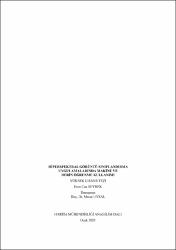| dc.contributor.advisor | Uysal, Murat | |
| dc.contributor.author | Seyrek, Eren Can | |
| dc.date.accessioned | 2021-02-16T09:27:27Z | |
| dc.date.available | 2021-02-16T09:27:27Z | |
| dc.date.issued | 2021 | en_US |
| dc.identifier.uri | https://hdl.handle.net/11630/8546 | |
| dc.description.abstract | Uzaktan algılama (UA) ile elde edilen görüntüler dünya yüzeyindeki nesneler hakkında detaylı bilgi toplanmasını mümkün kılmaktadır. Elde edilen görüntülerin sınıflandırılmasıyla oluşturulan arazi örtüsü haritaları kaynakların izlenmesi, çevresel değişimin tespiti ve planlama gibi birçok alanda geniş bir kullanım alanına sahiptir. Dolayısıyla harita kullanıcıları doğru ve güvenilir arazi örtüsü haritalarına ihtiyaç duymaktadır. Temel sınıflardan oluşan haritaların üretilmesi için multispektral sensörlerden elde edilmiş veriler yeterli olurken, özellikle tür içi farklılar içeren sınıflar da dahil olmak üzere detaylı sınıfların bulunması bu verilerin sınıflandırma için yeterli spektral bilgiyi sağlayamamasına yol açmaktadır. Bu durumda yüzlerce dar aralıkta banda sahip olan hiperspektral görüntülerin, nesneler hakkında daha detaylı spektral yansıtım bilgisini sunmaktadır. Hiperspektral görüntülerin geleneksel yöntemlerle sınıflandırılması hesaplama zorluğu sebebiyle yetersiz kalmaktadır. Bu durumda Makine Öğrenme (MÖ) ve Derin Öğrenme (DÖ) gibi yöntemler kullanıcılara bu tarz verilerde birçok avantaj sunmaktadır.
Bu tez kapsamında MÖ yöntemlerinden Destek Vektör Makineleri, Rastgele Orman, DÖ’de özellikle görüntü sınıflandırma alanında yaygın olarak kullanılan Evrişimli Sinir Ağı (ESA) kullanılmıştır. Çalışmada kullanılan ESA mimarileri yapısal özelliklerine göre 2B ESA ve 3B+2B ESA olarak isimlendirilmiştir. Yöntemlerin karşılaştırılması 176 bant spektral ve 30 metre konumsal çözünürlüklü HyRANK, 144 bant ve 2,5 metre konumsal çözünürlüklü DFC13 ile 202 bant ve 3,7 metre konumsal çözünürlüklü Salinas Scene veri setleri ile gerçekleştirilmiştir. Modellerde eğitim veri setinin etkisini araştırmak amacıyla her veri seti için 30%, 50% ve 70% eğitim veri kümesi oranları test edilmiştir. Çalışma sonucunda ESA modellerinin hiperspektral görüntülerin sınıflandırılmasında kullanımının yüksek doğruluk sağladıkları görülmüştür. Eğitim veri kümesi boyutunun araştırılması aşamasında ise beklendiği üzere 70% eğitim verisi kullanımının en yüksek doğruluğu sağladığı, bunun yanında 30% veri seti kullanımının da tatmin edici bir sınıflandırma doğruluğu sağladığı söylenebilir. | en_US |
| dc.description.abstract | Remotely sensed images enable to collect detailed information about objects on the earth's surface. Land cover maps created by classifying the remotely sensed images have a wide range of uses in many areas such as monitoring resources, detecting environmental change and planning. Therefore, map users need accurate and reliable land cover maps. Images which obtained from multispectral sensors is sufficient to produce maps consisting of basic classes. However, the existence of detailed classes that including classes with intra-species differences causes these data to not provide sufficient spectral information for classification. In this case, hyperspectral images with hundreds of narrow bands offer more detailed spectral reflection information about objects. Classification of hyperspectral images by traditional methods is insufficient due to calculation difficulties. In this case, methods such as Machine Learning and Deep Learning offer many advantages to users in such data.
In this thesis, Support Vector Machines, Random Forest, and Convolutional Neural Network (CNN), which are widely used in the field of image classification in Deep Learning were used for classifying hyperspectral images. The CNN architectures used in the study are named as 2D CNN and 3D + 2D CNN according to their structural features. Comparison of the methods was performed with HyRANK (176 band spectral and 30 meter spatial resolution), DFC13 (144 band and 2,5 meter spatial resolution), Salinas Scene (202 band and 3,7 meter spatial resolution) data sets. In order to investigate the effect of training data set on models, 30%, 50% and 70% training data set ratios were tested for each data set. As a result of the study, it was seen that the use of CNN models for classification of hyperspectral images provided high accuracy. When investigating the size of the training dataset, it can be said that the use of 70% training data provides the highest accuracy as expected, while the use of 30% data set provides a satisfactory classification accuracy. | en_US |
| dc.language.iso | tur | en_US |
| dc.rights | info:eu-repo/semantics/openAccess | en_US |
| dc.subject | Hiperspektral görüntü | en_US |
| dc.subject | Görüntü sınıflandırma | en_US |
| dc.subject | Makine öğrenme | en_US |
| dc.subject | Destek vektör makineleri | en_US |
| dc.subject | Rastgele orman | en_US |
| dc.subject | Derin öğrenme | en_US |
| dc.subject | Evrişimli sinir ağı | en_US |
| dc.title | Hiperspektral görüntü sınıflandırma uygulamalarında makine ve derin öğrenme kullanımı | en_US |
| dc.title.alternative | The use of machine and deep learning on hyperspectral image classification applications | en_US |
| dc.type | masterThesis | en_US |
| dc.department | Mühendislik Fakültesi | en_US |
| dc.identifier.startpage | 1 | en_US |
| dc.identifier.endpage | 137 | en_US |
| dc.relation.publicationcategory | Tez | en_US |
| dc.contributor.institutionauthor | Seyrek, Eren Can | |



















